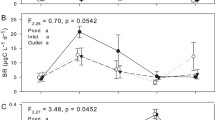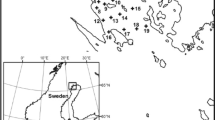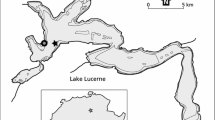Abstract
Organic carbon (C) in lakes originates from two distinct sources—primary production from within the lake itself (autochthonous supply) and importation of organic matter from the terrestrial watershed (allochthonous supply). By manipulating the 13C of dissolved inorganic C, thereby labeling within-lake primary production, we examined the relative importance of autochthonous and allochthonous C in supporting bacterial production. For 35 days, NaH13CO3 was added daily to two small, forested lakes. One of the lakes (Peter) was fertilized so that primary production exceeded total respiration in the epilimnion. The other lake (Tuesday), in contrast, was low in productivity and had high levels of colored dissolved organic C (DOC). To obtain bacterial C isotopes, bacteria were regrown in situ in particle-free lake water in dialysis tubes. The contribution of allochthonous C to bacterial biomass was calculated by applying a two-member mixing model. In the absence of a direct measurement, the isotopic signature of the autochthonous end-member was estimated indirectly by three different approaches. Although there was excess primary production in Peter Lake, bacterial biomass consisted of 43–46% allochthonous C. In Tuesday Lake more than 75% of bacterial growth was supported by allochthonous C. Although bacteria used autochthonous C preferentially over allochthonous C, DOC from the watershed contributed significantly to bacterial production. In combination with results from similar experiments in different lakes, our findings suggest that the contribution of allochthonous C to bacterial production can be predicted from ratios of chromophoric dissolved organic matter (a surrogate for allochthonous supply) and chlorophyll a (a surrogate for autochthonous supply).



Similar content being viewed by others
References
Bade DL. 2004. Ecosystem carbon cycles: whole-lake fluxes estimated with multiple isotopes [thesis]. Madison: University of Wisconsin
Baines BB, Pace ML. 1991. The production of dissolved organic matter by phytoplankton and its importance to bacteria: patterns across marine and freshwater systems. Limnol Oceanogr 36:1078–90
Carpenter SR, Kitchell JF, Eds. 1993. The trophic cascade in lakes. Cambridge (UK): Cambridge University Press, 385 p
Carpenter SR, Kitchell JF, Cottingham KL, Schindler DE, Christensen DL, Post DM, Voichick N. 1996. Chlorophyll variability, nutrient input and grazing: evidence from whole-lake experiments. Ecology 77:725–35
Carpenter SR, Cole JJ, Pace ML, Van de Bogert M, Bade DL, Bastviken D, Gille C, and others. 2005. Ecosystem subsidies: terrestrial support of aquatic food webs from 13C addition to contrasting lakes. Ecology, 86:2737–2750
Cimberlis ACP, Kalff J. 1998. Planktonic bacterial respiration as a function of C:N:P ratios across temperate lakes. Hydrobiologia 384:89–100
Coffin RB, Cifuentes LA. 1999. Stable isotope analysis of carbon cycling in the Perdido Estuary, Florida. Estuaries 22:917–26
Coffin RB, Fry B, Peterson BJ, Wright RT. 1989. Carbon isotopic compositions of estuarine bacteria. Limnol Oceanogr 34:1305–10
Cole JJ, Caraco NF, Kling GW, Kratz TK. 1994. Carbon dioxide supersaturation in the surface waters of lakes. Science 265:1568–70
Cole JJ, Pace ML, Carpenter SR, Kitchell JF. 2000. Persistence of net heterotrophy in lakes during nutrient addition and food web manipulations. Limnol Oceanogr 45:1718–30
Cole JJ, Carpenter SR, Kitchell JF, Pace ML. 2002. Pathways of organic carbon utilization in small lakes: results from whole-lake 13C addition and coupled model. Limnol Oceanogr 47:1664–75
D’Elia CF, Steudler PA, Corwin N. 1977. Determination of total nitrogen in aqueous samples using persulfate digestion. Limnol Oceanogr 22:760–4
Dillon PJ, Molot LA. 1994. Dissolved organic and inorganic carbon mass balances in central Ontario lakes. Biogeochemistry 36:29–42
Ducklow HW, Purdie DA, Williams PJleB, Davies JM. 1986. Bacterioplankton: a sink for carbon in a coastal marine plankton community. Science 232:865–7
Fry B, Brand W, Mersch FJ, Tholke K, Garritt RH. 1992. Automated analysis system for coupled 13C and 15N measurements. Anal Chem 64:289–91
del Giorgio PA, Peters RH. 1994. Patterns in planktonic P:R ratios in lakes: influence of lake trophy and dissolved organic carbon. Limnol Oceanogr 39:772–87
del Giorgio PA, Cole JJ, Caraco NF, Peters RH. 1999. Linking planktonic biomass and metabolism to net gas fluxes in northern temperate lakes. Ecology 88:1422–31
Hanson PC, Bade DL, Carpenter SR. 2003. Lake metabolism: relationships with dissolved organic carbon and phosphorus. Limnol Oceanogr 48:1112–9
Herndl GJ, Kaltenbock E, Müller-Niklas G. 1993. Dialysis bag incubation as a non-radiolabeling technique to estimate bacterioplankton production in situ. In: Kemp PF, Sherr BF, Sherr EB, Cole JJ, Eds. Handbook of methods in aquatic microbial ecology. Lewis, p 553–6
Hobbie JE, Daley RJ, Jasper S. 1977. Use of Nuclepore filters for counting bacteria by fluorescence microscopy. Appl Environ Microbiol 33:1225–8
Jahne B, Munnich KO, Bosinger R, Dutzi A, Huber W, Libner P. 1987. On parameters influencing air-water gas exchange. J Geophys Res 92:1937–49
Jansson M, Karlsson J, Blomqvist P. 2003. Allochthonous organic carbon decreases pelagic energy mobilization in lakes. Limnol Oceanogr 48:1711–6
Kirchman DL. 1993. Leucine incorporation as a measure of biomass production by heterotrophic bacteria. In: Kemp PF, Sherr BF, Sherr EB, Cole JJ, Eds. Handbook of methods in aquatic microbial ecology. Lewis: Boca Raton, Florida, USA, p 509–12
Kritzberg ES, Cole JJ, Pace ML, Granéli W, Bade D. 2004. Autochthonous versus allochthonous carbon sources to bacteria: results from whole-lake 13C addition experiments. Limnol Oceanogr 49:588–96
Kritzberg ES, Cole JJ, Pace ML, Granéli W. 2005. Does autochthonous primary production drive variability in bacterial metabolism and growth efficiency in lakes dominated by terrestrial C inputs? Aquat Microb Ecol 38:103–11
Kroer N. 1993. Bacterial growth efficiency on natural dissolved organic matter. Limnol Oceanogr 38:1282–90
Lajtha K, Michener RH. 1994. Sources of variation in the stable isotopic composition of plants. In: Lajtha K, Michener RH, Eds. Stable isotopes in ecology and environmental science. Oxford: Blackwell, p 1–21.
Pace ML, Cole JJ. 1996. Regulation of bacteria by resources and predation tested in whole-lake experiments. Limnol Oceanogr 41:1448–60
Pace ML, Cole JJ, Carpenter SR, Kitchell JF, Hodgson JR, Van de Bogert MC, Bade DL, et al 2004. Whole-lake carbon-13 additions reveal terrestrial support of aquatic food webs. Nature 427:240–3
Paerl HW. 1978. Microbial organic carbon recovery in aquatic ecosystems. Limnol Oceanogr 23:927–35
Pomeroy LR. 1974. The ocean food web: a changing paradigm. Bioscience 24:499–504.
Rasmussen JB, Godbout L, Schallenberg M. 1989. The humic content of lake water and its relationship to watershed and lake morphometry. Limnol Oceanogr 34:1336–43
Riera JL, Schindler JE, Kratz TK. 1999. Seasonal dynamics of carbon dioxide and methane in two clear-water lakes and two bog lakes in Northern Wisconsin, USA. Can J Fish Aquat Sci 56:265–74
Smith DC, Azam F. 1992. A simple, economical method for measuring bacterial protein synthesis rates in sea water using 3H-leucine. Mar Microb Food Webs 6:107–9
Vrede K, Vrede T, Isaksson A, Karlsson A. 1999. Effects of nutrients (phosphorus, nitrogen, and carbon) and zooplankton on bacterioplankton and phytoplankton — a seasonal study. Limnol Oceanogr 44:1616–24
Wanninkhof R, Ledwell JR, Broecker WS. 1985. Gas-exchange – wind speed relation measured with sulfur hexafluoride on a lake. Science 227:1224–6
Wetzel RG. 1995. Death, detritus and energy flow in aquatic ecosystems. Freshw Biol 33:83–9
Wetzel RG. 2001. Limnology: lake and river ecosystems. 3rd ed. New York: Academic Press. 1006 p.
Acknowledgements
We are grateful for financial support from the National Science Foundation (DEB 9509595), the Swedish Research Council (VR; contract B 5103-649), and the Crafoord Foundation. We thank M. Van de Bogert, D. Bade, G. Birgersson, and C. Fankhauser for technical assistance. Work at the University of Notre Dame Environmental Research Center was facilitated by R. Hellenthal, J. Runde, G. Belovsky, and J. Caudel, and we thank B. Montgomery at ISOTEC for assistance with the purchase of the large quantity of 13C required for these experiments. Finally, we thank Robert Wetzel, Erik Jeppessen, and an anonymous reviewer for greatly improving a previous version of this paper. This is a contribution to the Department of Ecology/Limnology at Lund University and the Institute of Ecosystem Studies.
Author information
Authors and Affiliations
Corresponding author
Rights and permissions
About this article
Cite this article
Kritzberg, E.S., Cole, J.J., Pace, M.M. et al. Bacterial Growth on Allochthonous Carbon in Humic and Nutrient-enriched Lakes: Results from Whole-Lake 13C Addition Experiments. Ecosystems 9, 489–499 (2006). https://doi.org/10.1007/s10021-005-0115-5
Received:
Accepted:
Published:
Issue Date:
DOI: https://doi.org/10.1007/s10021-005-0115-5




